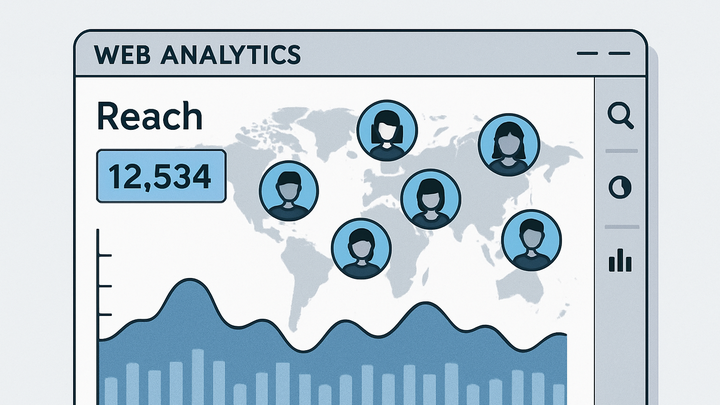Published on 2025-06-26T04:36:59Z
What is Reach? Examples of Measuring Reach in Analytics
Reach is a key metric in web analytics that quantifies the number of unique individuals who have been exposed to your content, website, or advertising campaign within a specified time frame. Unlike pageviews or impressions, which count every load or display, reach deduplicates repeated interactions by the same user. This metric helps marketers understand the actual audience size and measure campaign effectiveness beyond raw view counts. By analyzing reach, teams can assess their brand’s visibility, optimize channel strategies, and identify audience saturation points. Reach can also be segmented by demographics, geography, or device to provide granular insights into which audiences are being reached most effectively. Tools like GA4 and PlainSignal offer built-in reach reporting, with PlainSignal delivering a privacy-focused, cookie-free approach.
Reach
Reach is the number of unique individuals exposed to content over a specified period in web analytics.
Understanding Reach
Reach represents the count of distinct users who have seen your content at least once during the reporting period. It differs from other volume metrics by focusing on unique exposure rather than total interactions.
-
Unique users explained
Reach counts each visitor once regardless of multiple sessions or page views. It reveals the true size of your audience by deduplicating repeat visits.
-
Reach vs impressions
While impressions tally every time content is displayed, reach focuses on the number of distinct individuals who saw it. For example, a single user viewing a page five times counts as one in reach but five in impressions.
Measuring Reach with SaaS Tools
Different analytics platforms offer built-in metrics and reports to track reach. Here’s how to measure reach using popular tools:
-
Using GA4
In Google Analytics 4, navigate to the “User Acquisition” report and look at the “Total Users” metric over your chosen time frame. You can also build custom Explorations to segment reach by source, geography, or device.
-
Using PlainSignal (cookie-free analytics)
PlainSignal tracks reach without cookies, focusing on privacy-first data collection. To implement, add the following snippet to your HTML:
<link rel="preconnect" href="//eu.plainsignal.com/" crossorigin /> <script defer data-do="yourwebsitedomain.com" data-id="0GQV1xmtzQQ" data-api="//eu.plainsignal.com" src="//cdn.plainsignal.com/plainsignal-min.js"></script>In the PlainSignal dashboard, view the “Unique Visitors” metric as your reach indicator.
Why Reach Matters
Reach provides insights into how widely your content or campaigns are resonating. It helps you gauge audience size, optimize resource allocation, and measure potential brand exposure.
-
Assess campaign scale
High reach indicates broad visibility. Use it to determine if your campaign is reaching enough potential customers to justify budget spend.
-
Identify audience saturation
Tracking reach over time can reveal when you’ve tapped out your current audience and need to explore new channels or messaging.
Best Practices & Common Pitfalls
Ensure accurate reach measurement by following these guidelines and avoiding typical errors.
-
Filter out bot traffic
Bots can inflate reach metrics. Implement bot filtering and validate data sources to maintain data quality.
-
Consistent time frames
Comparing reach across inconsistent periods can lead to misinterpretation. Always standardize reporting windows (e.g., weekly vs. monthly).
